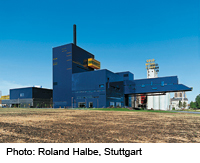Guthrie-Theatre in Minneapolis

In 1963, Tyrone Guthrie founded a theatre on European lines in Minneapolis. The “Guthrie”, as it was known, became one of the most important theatres in the US, but forty years later, the old building was too small for the many functions it had to accommodate. To counter the advancing desolation of its inner-urban areas, Minneapolis, like other US cities, has erected a number of buildings for the arts, and the new Guthrie Theatre can be seen in this context. The site chosen was a former grain distribution area on the banks of the Mississippi. The new complex contains an arena-like auditorium – as in the previous building – as well as a rectangular theatre space and a small studio stage.
In 2001, Jean Nouvel was entrusted with the planning. His concept proposed three auditoriums raised above the ground to afford visitors a view over the largely industrial riverscape. A 53-metre-long cantilivered arm and a series of vertical and horizontal cubic volumes conjure associations of industrial buildings like the huge grain silos nearby. The new structure is thus related to its surroundings, yet at the same time contrasted with them by virtue of its smooth cladding of dark-blue metal panels. A vertical seam divides the complex into two halves and forms a link at ground level between the river front and the street face. Visitors enter the theatre at the ends of this 12-metre-wide space and ascend to the foyer at third-floor level via two long escalators. From there, they have access to the two large auditoriums. Many theatregoers proceed to the turning point of a long ramp within the cantilevered arm – from where they have a spectacular view over the river – before continuing to the upper foyer. Two circular openings in the floor create visual links between the foyer levels. The studio theatre on the seventh floor can be reached only by lift. The foyer to this space, a yellow glazed box suspended freely in front of the facade, forms the culmination of a spectacular promenade. In this building, one finds many of the opulent spatial features that are typical of the architecture of Jean Nouvel.
